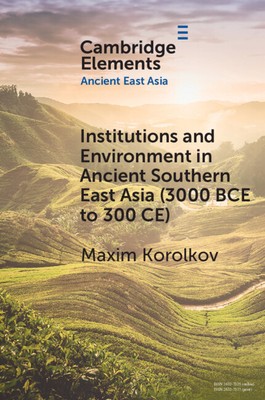
- Išsiųsime per 10–14 d.d.
- Autorius: Maxim Korolkov
- Leidėjas: Cambridge University Press
- ISBN-10: 1108964672
- ISBN-13: 9781108964678
- Formatas: 15.2 x 22.9 x 0.5 cm, minkšti viršeliai
- Kalba: Anglų
- Extra -15 % nuolaida šiai knygai su kodu: ENG15
Institutions and Environment in Ancient Southern East Asia (3000 Bce to 300 Ce) (el. knyga) (skaityta knyga) | knygos.lt
Atsiliepimai
Aprašymas
Over the past decades, archaeological exploration of southern China has shattered this image of primitive indigenous people and their pristine environments. We know, for example, that East Asia's largest settlements and hydraulic infrastructures in the third millennium BCE were located in the Yangzi valley, as were some of the most sophisticated metallurgical centers of the following millennium. If southern East Asia was not a backward periphery of the Central Plains, then what created the power asymmetry that made possible "China's march toward the Tropics"? What did becoming "Chinese" practically mean for the local populations south of the Yangzi? Why did some of them decide to do so, and what were the alternatives? The present Element focuses on the specific ways people in southern East Asia mastered their environment through two forms of cooperation: centralized and intensive, ultimately represented by the states, and decentralized and extensive, exemplified by interaction networks.
EXTRA 15 % nuolaida su kodu: ENG15
Akcija baigiasi už 5d.02:32:01
Nuolaidos kodas galioja perkant nuo 10 €. Nuolaidos nesumuojamos.

- Autorius: Maxim Korolkov
- Leidėjas: Cambridge University Press
- ISBN-10: 1108964672
- ISBN-13: 9781108964678
- Formatas: 15.2 x 22.9 x 0.5 cm, minkšti viršeliai
- Kalba: Anglų Anglų
Over the past decades, archaeological exploration of southern China has shattered this image of primitive indigenous people and their pristine environments. We know, for example, that East Asia's largest settlements and hydraulic infrastructures in the third millennium BCE were located in the Yangzi valley, as were some of the most sophisticated metallurgical centers of the following millennium. If southern East Asia was not a backward periphery of the Central Plains, then what created the power asymmetry that made possible "China's march toward the Tropics"? What did becoming "Chinese" practically mean for the local populations south of the Yangzi? Why did some of them decide to do so, and what were the alternatives? The present Element focuses on the specific ways people in southern East Asia mastered their environment through two forms of cooperation: centralized and intensive, ultimately represented by the states, and decentralized and extensive, exemplified by interaction networks.


Atsiliepimai